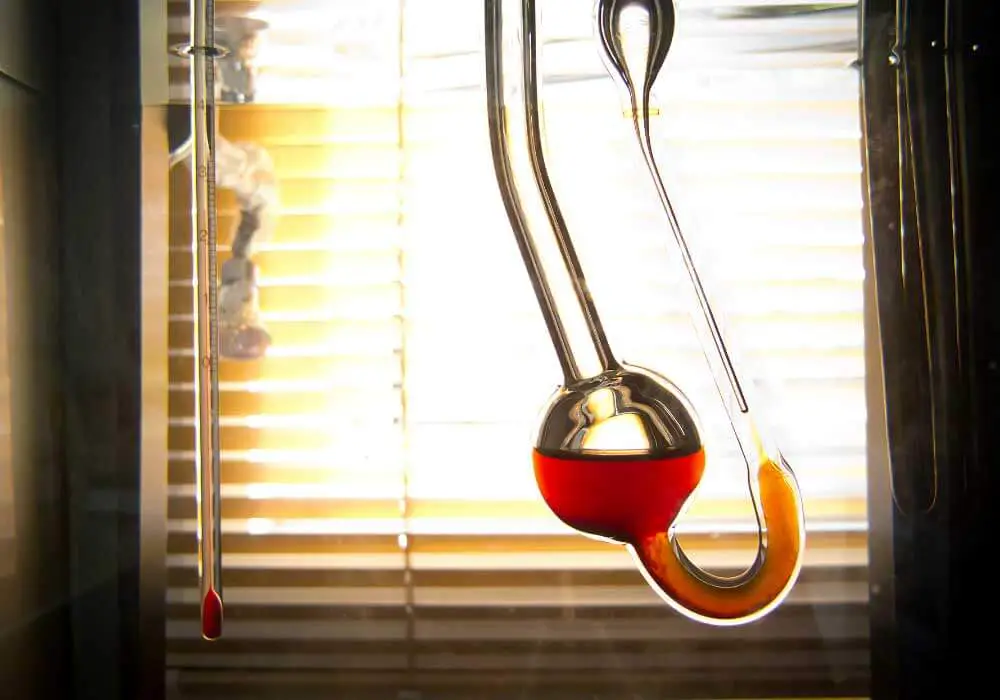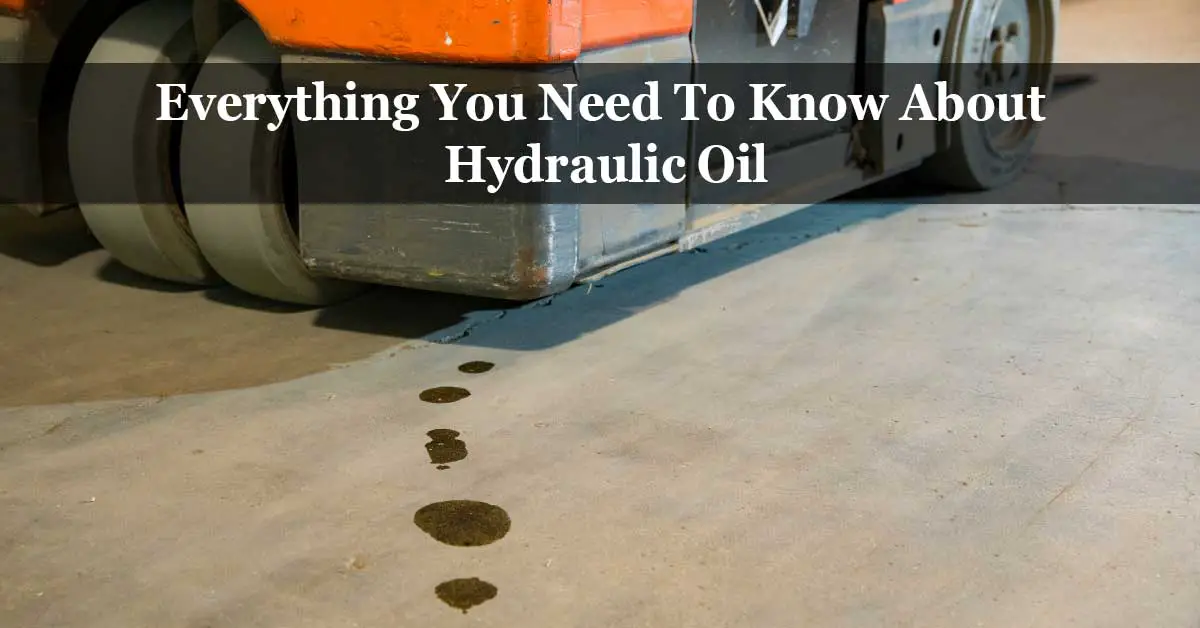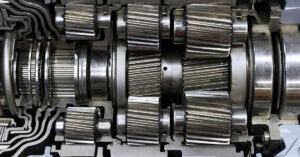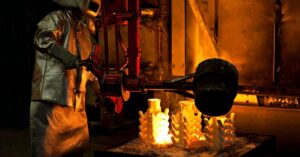Hydraulic oil (hydraulic fluid) is a synthetic or mineral fluid used to transfer power in hydraulic equipment and machinery. The hydraulic fluid conveys energy in the form of flowrate and pressure.
Although all liquids would qualify to convey energy in hydraulic systems, the liquid requires certain physical and chemical characteristics to qualify as hydraulic oil. Certain fluids cannot be used in hydraulic systems due to their physical and chemical characteristics, such as water or vegetable oil. Water freezes, do not lubricate and becomes oxidized when in contact with air, while vegetable oil decomposes and rapidly becomes oxidized in the presence of heat and air.
Hydraulic Oil Additives
Hydraulic oil additives are the chemical additives added to hydraulic oil to improve and upgrade certain physical or chemical characteristics depending on oil intended use. The oil is known as doped, and the chemical additive improving certain physical or chemical characteristics of oil is known as dopes.
Most doped hydraulic oils’ characteristics dwindle rapidly with ageing and overheating; therefore, doped oils are not common and used only for special purposes.
Hydraulic Oil Contamination
Hydraulic oil contamination plays a major role in hydraulic systems failure; the causes of contamination are:
- Initial contamination which presents in the system before oil filling. Initial contamination is such as non-decarbonized piping, oxides produced by welding, oxidized parts in contact with the oil, poor storage conditions of equipment, and uncovered orifices. The remedies are decarbonization, flushing, passivation of all the components in contact with the oil and proper storage of the equipment and adequate blanking of all the orifices.
- External contamination which an introduction in the system of elements from the surrounding medium. Oils are very often used in relatively dirty places like worksites, very seldom in totally clean atmospheres. The remedies are proper filtering during return stroke and maintain a good condition of hydraulic seals.
- Functional contamination which is due to the movement of hydraulic parts. Functional wear is the wear concerns pumps, motors, actuators and other hydraulic components. The remedy is usually by using efficient filtering process.
- Man-induced contamination which penetrates to the system during maintenance tasks. The remedies are working in clean atmospheres, interruption of ventilation during disassembly and reassembly operations, and proper blanking of piping and hydraulic components’ orifices.
Consequences of Contamination
Gumming
The risks of gumming are increased by long rest periods of the equipment and the presence of impurities in the fluid. Gumming is characterized by the formation of a micrometric sludge. This sludge sometimes hardens into a very hard varnish, and a press may be required to remove the components.
Seizing
Seizing occurs in moving parts and is caused by the presence of metal contaminants in the oil.
Erosion
Erosion is due to the very high speed of the fluid. This progressive and irreversible phenomenon is aggravated by oil contamination.
Obstruction and clogging
Obstruction concerns the parts with small orifices. These are easily obstructed by particles in suspension in the fluid.
Treatments of Contamination
Filtering
Oil filtering, whether it is performed within the system during operation or filling, is the only efficient remedy against contamination.
Draining
Draining is the operation consisting of replacing all the fluid in the hydraulic system. It is performed when pollutants’ concentration becomes too high or when the oil characteristics are much also downgraded.
Draining is usually a systematic maintenance operation performed at regular intervals. Its periodicity is specific to each type of machine. On average, draining is due every 500, 1,000 or 2,000 hours.
Hydraulic fluid quality becomes downgraded with use, and the occurrence of pollutants in the system is inevitable. Therefore, it is necessary to drain the system at time intervals, which depend on the system requirements in terms of oil quality.
Flushing
Flushing is carried out with the oil used for filling and consists of operating the entire system for a certain period.
Flushing is:
- Necessary if the oil condition is considered as unfit. For instance, the US standard NASI 1638 defines contamination classes from 00 to 12 by giving each class the maximum number of particles admitted and their size for a 100 cm3 oil sample.
- Obligatory in case of an oil change.
Properties of Hydraulic Oil
Hydraulic Oil Density
Density is the ratio between the mass of a volume of oil and that of the same volume of water at 4°C.
Usually, the density of oil is given at 15°C. The density of an oil increases with its wear means with the use and ageing process.
Hydraulic Oil Viscosity
The viscosity is the property of fluids by virtue of which they offer a resistance to flow in a tube at a given temperature; it is measured in degrees Engler according to the SAE standard. Viscosity characterizes the ability of the oil to flow more or less easily. The higher the viscosity, the more difficult it is for the fluid to flow at a temperature and pressure.
If viscosity is high:
- Leaks are reduced.
- Head losses increase; head losses mean the pressure drop due to the clearing of an obstacle or to the effects of viscosity on a line.
- The cavitation phenomenon can appear, cavitation means when the pressure in a liquid goes below a certain value, a part of the fluid vaporizes, which results in the appearance of bubbles. This can be harmful to the pump output or to that of its components.
- The functioning progressiveness decreases.
- The working temperature increases.
- The lack of an oil film can cancel cold lubrication.
If viscosity is too low:
- Leaks increase.
- The tightness of the pumps is insufficient, and the pressure decreases.
- Lubrication can be canceled by a break in the continuity of the oil film.
Measurement of viscosity
When measuring viscosity, we distinguish:
- The kinematic viscosity with the stoke as a unit of measurement.
- The dynamic viscosity with the Poiseuille.
For industrial use, knowing the kinematic viscosity is usually enough. It is measured with a Viscometer; Viscometer is a funnel with a calibrated outlet port for measuring a fluid’s viscosity.
The latter can be measured with a viscometer and according to three methods.
- Degrees Engler: The measurement in degrees Engler is the ratio of the flow time of the oil to the flow time of the same volume of water. The measurement is carried out at 20°C by a 20 mm long port with a diameter of 2.8 mm.
- Redwood seconds: The Redwood seconds’ measurement represents the flow time of 50 cm3 of the considered fluid at 60°F (21.1°C) in a 10 mm long port with a diameter of 1.62 mm.
- Saybolt Universal Seconds: The measurement in Saybolt universal seconds represents the flow time of 60 cm3 of the considered fluid at 70°F (22.1°C) in a 12.2 mm long port with a diameter of 1.75 mm.

Viscosity index
The viscosity index characterizes the viscosity of the oil. It is designated by the acronym SAE followed by a number. In practice, this number is called grade (Example: SAE 10 – SAE 30 – SAE 90). The higher the grade, the more viscous the oil. This designation is arbitrary because certain factors disturb viscosity, in particular temperature.
The viscosity index (VI) is a coefficient that characterizes the change in the oil’s viscosity according to temperature. The higher the VI, the less the viscosity of oil varies with temperature; we then speak of multi-grade oil.
The indexing scale is determined as follows:
- The coefficient 0 is assigned to asphaltic oil, an oil very sensitive to changes in temperature;
- The coefficient 100 is assigned to paraffin type oil, an oil little sensitive to changes in temperature.
These two types of oils have the same viscosity at 210°F (100°C).
Modern hydraulic oils that have a VI superior to 100 are called VIE (Viscosity Index Extended) oils. An oil with a viscosity index that would not vary according to temperature is nowadays chemically unfeasible.
Lubricity
Lubricity is a liquid’s ability to resist being wiped or squeezed out from between the surfaces when spread out in an extremely thin layer. The hydraulic oil must ensure the lubrication of the system’s various components, whatever the working conditions. This lubrication ability is linked to the cohesive force between the molecules of oil so that a permanent film can be kept between the parts in motion.
Neutrality
Neutrality is the acidity of the oil. The oil must contain a percentage as low as possible of acid elements likely to attack the system’s components. The acid number or the neutralization value represents the number of milligrams of potash (base) necessary to neutralize one gram of oil’s acidity.
Chemical Stability
Chemical stability is the liquid’s ability to resist oxidation and deterioration for long periods.
When the oil is in use, the oil is likely to lose some of its chemical characteristics. The chemical characteristics alternation may result in reactions due to changes in temperature, the ageing process, or oxidation due to air and water contact.
The decomposition of the oil causes its alteration in color or odor, deposits on the components, and a lesser effect of the basic characteristics, leading to their cancellation.
The oils with high chemical characteristics are usually doped oils. However, as additives are very sensitive to special conditions of use, these oils are therefore relatively unstable. Consequently, it is formally not recommended to use special oil for any application different from what has been prescribed.
Demulsification Number
Desemulsification number is the ability of the oil to separate from the water it can contain. The presence of water is usually due to condensation in the reservoir, an air intake on a suction line, or a jet cleaning of the equipment.
The mixing oil/water generates an emulsion, which forms a whitish mud reacting to certain additives, which precipitate and accelerate the phenomenon, leading to the loss of all the qualities of the oil. In general, light oil emulsifies less than heavy oil.
The demulsification number indicates the time necessary for a certain amount of water emulsified with oil to separate from the water at a given temperature. The measurement methods can vary, but the process remains unchanged.
Antifoam Power
The antifoam power is the oil’s ability to reduce the formation of foam due to the mixing of the air it contains. Antifoam power characterizes the easiness with which the oil separates from the air it contains.
Any oil contains dissolved air (about 10% in volume), which is released during the phenomenon of cavitation. This air presence can also be due to air intakes on the system during suction or change of oil level in the reservoir.
The air bubbles mixed with the oil create a foam. The presence of air leads to the pump’s irregular functioning and the receivers and quick oxidation of the oil. The dopes (Chemical additives) reduce the formation of foam. But the classical solution to remove the foam and the air is to use a high capacity reservoir where the oil can stand.
Anticorrosive Power
The anticorrosive power is obtained by adding dopes because it is impossible to avoid the inlet of dampness in a hydraulic system. The oxidation is a frequent phenomenon on intermittent systems (stored vehicles).
Aniline Point
The aniline point is the lowest temperature at which aniline and a solvent are completely miscible and indicate the type of hydrocarbons present in the solvent. The aniline point characterizes the oil’s action to rubber components according to these components’ chemical composition. If the oil has a low aniline point, the rubber softens and swells, then it decomposes. If the oil has a high aniline point, the rubber hardens and cracks.
Resistance to Cold
For petroleum products submitted to cold, there is first a more or less quick increase in viscosity. Then, suppose the decrease in temperature is great enough. In that case, these products stop being real fluids and, as a result of their thickening, become close to the solid-state by being submitted to modifications resulting from various complex phenomena.
Pour Point
Pour point is the lowest temperature at which the oil still flows when it is cooled, not stirred, in standardized conditions. This characteristic is very important for systems designed to work at very low temperatures.
Cloud Point
Cloud Point is the temperature at which a liquid starts solidifying or separating from the solution when the oil has cooled in standardized conditions.
Flashpoint
Flashpoint is the temperature to which the oil must be heated, for it can give off vapors, which will ignite when a flame is applied.
Hydraulic Oil Grades
The International Standards Organisation “ISO” Grade the hydraulic oil based on the viscosity using the symbol VG with a number; the higher the VG number, the more viscous the fluid is and vice versa.
Other standard organizations grading hydraulic oil is the Society of Automotive Engineers (SAE) and American Gear Manufacturers Association (AGMA)
ISO grades oil as the following examples:
ISO VG 15 Hydraulic Oil means hydraulic oil with mid-point kinetic viscosity of 15 mm2/s at 40C.
ISO VG 32 Hydraulic Oil means hydraulic oil with mid-point kinetic viscosity of 32 mm2/s at 40C.
* mm2/s = cSt.
The common hydraulic oil grades are ISO VG 15, ISO VG 22, ISO VG 32, ISO VG 46, ISO VG68, and ISO VG 100.
Anti-wear Hydraulic Oil Grades
Adding the AW symbol to the oil grade indicates that the oil is with anti-wear properties. The difference is that there are additives contained within the oil to reduce the corrosion and ensure no metal-to-metal contact between machinery components. Most of the additives used for this are zinc-based; zinc has anti-oxidative and anti-wear qualities, extending machinery life.
The common Anti-wear hydraulic oil grades are:
AW 32 Hydraulic Oil
AW 46 Hydraulic Oil
AW 68 Hydraulic Oil
The Anti-wear hydraulic are used with gear, vane, radial, and axial piston pumps, which contain gears and bearings where mild anti-wear characteristics are required.
References:
- International Organization for Standardization.
- American Gear Manufacturers Association – AGMA.
- The Society of Automotive Engineers – SAE.







